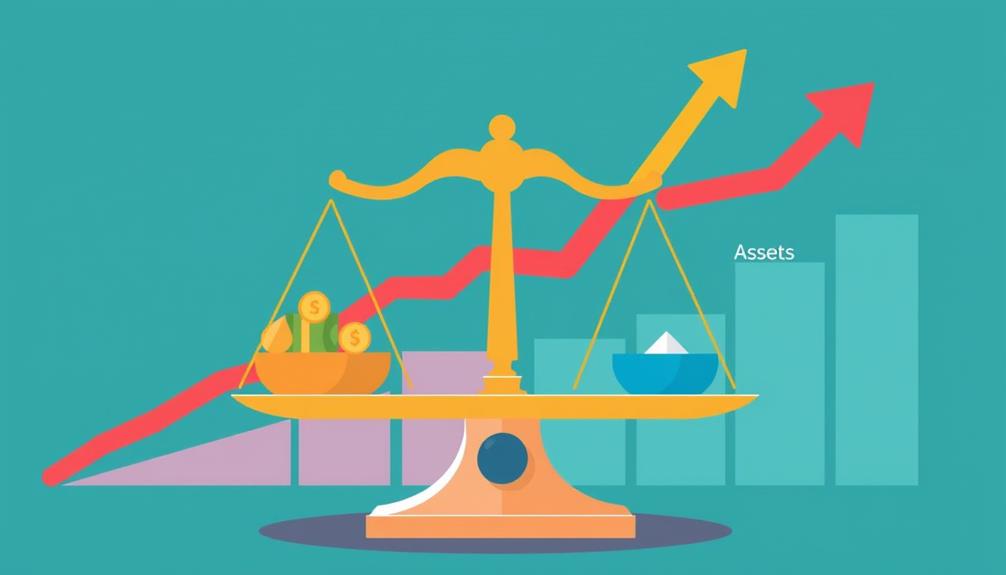Yes, tangible net worth (TNW) can absolutely be negative, and that fact might surprise you. This situation occurs when your total liabilities exceed your tangible assets, indicating potential financial instability. It's a warning signal that could complicate securing loans or attracting investors. For example, if your physical assets are valued at $300,000 while your debts are $400,000, your TNW lands at -$100,000. Regularly evaluating your TNW is essential to identifying and addressing these financial issues, ensuring you stay on top of your financial health and avoid pitfalls that could worsen your situation. There's more to uncover about how to manage TNW effectively. Understanding negative net worth in business is crucial for making informed financial decisions. It requires a thorough examination of your assets, liabilities, and overall financial standing. By carefully assessing your TNW, you can develop strategies to improve profitability, lower debt, and strengthen your financial position. Seeking the guidance of financial professionals can also provide valuable insights and assistance in navigating the challenges associated with negative net worth.
Key Takeaways
- Yes, Tangible Net Worth (TNW) can be negative when liabilities exceed tangible assets, indicating financial distress.
- Negative TNW often results from excessive debt accumulation compared to the growth of tangible assets.
- Companies, particularly startups and those in bankruptcy, frequently report negative TNW due to heavy initial investments and liabilities.
- Financial instability is signaled by negative TNW, making it challenging to secure financing or attract investors.
- Regular monitoring of TNW is crucial to identify financial issues and implement corrective actions to improve financial health.
Understanding Tangible Net Worth
When diving into the concept of tangible net worth (TNW), think of it as a snapshot of a company's financial health. TNW is calculated using the formula TNW = Total Assets – Total Liabilities – Intangible Assets. This formula provides clarity by focusing solely on a company's physical assets, excluding things like goodwill and patents that can't be easily liquidated.
Understanding common financial terms and jargon is important when analyzing TNW, as it can help clarify the implications of a company's asset structure and liabilities common financial terms.
A positive TNW signifies that a company's tangible assets exceed its total liabilities, indicating financial stability and an ability to repay debts. This is vital for investors and creditors, as it reflects the company's overall viability.
Conversely, if a business carries significant total liabilities and has minimal tangible assets, it may reveal a negative net worth. This situation highlights potential financial distress and escalates risks for those lending money or investing.
Regular assessments of TNW are important for accurate financial analysis, allowing you to gauge a company's ongoing health and make informed decisions.
How Negative TNW Occurs

Negative tangible net worth happens when your company's liabilities outweigh its tangible assets, signaling potential financial trouble.
This often results from taking on too much debt or relying on intangible assets that don't count toward TNW.
It's important to evaluate current sector performance metrics as they can provide insights into financial health.
If you ignore the impact of excessive liabilities or the exclusion of intangible assets, you might find your business in a precarious position.
Excessive Liabilities Impacting Value
Excessive liabilities can quickly erode a company's tangible net worth (TNW), leading to dire financial implications. When total liabilities surpass total tangible assets, you face a negative TNW, indicating that what you owe exceeds what you own in physical assets.
For instance, if your tangible assets are valued at $300,000 and your total liabilities hit $400,000, your TNW drops to -$100,000. This situation often arises from high levels of debt, like mortgages, loans, and credit obligations, which can accumulate faster than your tangible assets can grow.
Additionally, regulatory compliance is essential to guarantee that your financial practices don't lead to further liabilities that could exacerbate your negative TNW. Excessive liabilities not only diminish your TNW but also signal financial instability to creditors and investors. They see a negative TNW as a red flag, raising concerns about your risk of insolvency or bankruptcy.
To maintain financial health, it's essential to regularly monitor your liabilities. Fluctuations in your financial situation can swiftly transform a positive TNW into a negative one, impacting your overall creditworthiness and ability to secure future funding.
Intangible Assets Exclusion Effect
Understanding how intangible assets impact your tangible net worth (TNW) is essential for evaluating your financial health. Negative TNW occurs when your total liabilities exceed your tangible assets, indicating potential financial distress.
Even if your business possesses valuable intangible assets like patents or brand recognition, these are excluded from the TNW calculation. This exclusion can create a misleading picture of your overall net worth. Gold IRAs can serve as a strategic investment tool for those looking to stabilize their financial position, especially during periods of economic uncertainty and inflation a hedge against inflation.
In industries with high intangible asset values, such as technology or branding, it's possible to have a negative TNW while still maintaining a strong overall valuation. For example, if your company has significant debts—like loans and mortgages—that surpass the value of physical assets such as real estate and equipment, you could find yourself in negative territory.
A negative TNW is a critical signal to lenders and investors, suggesting your ability to meet obligations may be compromised. It's crucial to recognize that while intangible assets contribute to your business's strength, they don't factor into TNW.
This exclusion can lead to serious implications for your financial strategy, especially if you're seeking investment or financing. Understanding this dynamic can help you navigate potential challenges effectively.
Importance of Monitoring TNW

Monitoring your tangible net worth (TNW) is fundamental for maintaining financial health, as it allows you to ascertain that your tangible assets consistently exceed your liabilities.
Keeping an eye on your TNW not only guarantees financial stability but also helps you make informed decisions about asset management. Regular assessments can also provide insights similar to how tracking cold medications can help manage health effectively.
Here are some key reasons why tracking TNW is essential:
- Identify Financial Distress: A negative TNW can signal potential issues, prompting you to take corrective actions.
- Evaluate Asset Utilization: Regular assessments provide insights into how effectively you're using your assets over time.
- Gauge Liquidity: Monitoring TNW helps you assess your readiness for unexpected expenses or economic downturns.
- Attract Investors and Lenders: A strong TNW can enhance your appeal to potential investors and lenders, highlighting your creditworthiness.
- Prepare for Credit Applications: Lenders often prioritize TNW when evaluating borrowing capacity, so staying on top of this metric is crucial.
Key Components of TNW Calculation

When calculating your tangible net worth, you need to understand the key components involved.
You'll assess your total assets, which include cash, real estate, and equipment, while also evaluating your total liabilities, like debts owed.
It's important to recognize that investments in precious metals, such as those offered by Noble Gold, can provide a unique aspect to your overall portfolio, potentially enhancing your financial stability.
Don't forget to reflect on how intangible assets, though excluded from TNW, can still impact your overall financial picture.
Understanding Tangible Assets
Here is the revised MY ARTICLE SUBHEADING CONTENT:
Tangible assets play an essential role in calculating your tangible net worth (TNW), as they encompass the physical items your business owns, like cash, real estate, machinery, and inventory. Understanding these assets is fundamental because they directly impact your financial statements and help you calculate net worth accurately.
Additionally, investment strategies in precious metals can enhance the overall financial stability of your portfolio. Unlike intangible assets, which can complicate valuation, tangible assets are typically easier to appraise based on market value and liquidity.
Here are key components of tangible assets to take into account:
- Cash: Liquid assets that can be used immediately.
- Real Estate: Property that can appreciate in value over time.
- Machinery: Equipment that aids in production and operations.
- Inventory: Goods available for sale that contribute to revenue.
- Vehicles: Transportation assets essential for business operations.
Accurate valuation of tangible assets is necessary to avoid overvaluation, which can distort your TNW figures and lead to misleading interpretations.
Regularly updating the values in your financial statements guarantees that your TNW reflects your business's current financial health, giving you a clearer picture of your assets and liabilities.
Assessing Total Liabilities
Understanding your business's total liabilities is vital for an accurate tangible net worth (TNW) calculation. Total liabilities include all debts and obligations, which can be short-term, like unpaid invoices and credit card balances, or long-term, such as loans and mortgages.
These components greatly impact your TNW because the formula is TNW = Total Assets – Total Liabilities – Intangible Assets. Consequently, if your assets exceed your liabilities, it indicates a healthier financial position. Regularly considering investment strategies like gold investment options can also provide a buffer against financial downturns.
To assess total liabilities accurately, you need a thorough listing of all outstanding debts. Missing even one obligation can skew your TNW calculation and misrepresent your financial health.
Regularly updating your total liabilities is also important, as fluctuations can affect your TNW and provide insight into your ability to cover debts and sustain operations.
Importance of Intangible Assets
Evaluating your total liabilities gives a clear picture of your financial position, but it's also important to recognize the role of intangible assets in your overall valuation. While tangible assets provide immediate liquidity, intangible assets like patents, trademarks, and goodwill can greatly affect your net worth.
Additionally, the rise of technology sectors has created new opportunities for careers, such as AI software engineer jobs, emphasizing the importance of innovation and intellectual property in today's economy.
Remember, intangible assets are excluded from the tangible net worth (TNW) calculation, yet they can enhance your financial stability. Here are some key points to take into account:
- Intangible assets can contribute to a higher overall valuation.
- Companies with high intangible assets may still report negative TNW.
- The valuation of intangible assets is often subjective and can vary widely.
- Strong intangible assets can improve your business's perceived worth.
- Understanding these assets can help you make informed financial decisions.
Even if your TNW appears negative, this doesn't mean your overall financial health is poor. A robust portfolio of intangible assets can still enhance your company's valuation and resilience in the market.
It's essential to look beyond tangible assets to fully grasp your financial landscape and future potential.
Implications of Negative TNW

What happens when a company's tangible net worth (TNW) turns negative? You face serious implications that can jeopardize its future. A negative TNW indicates that your liabilities exceed your tangible assets, which signals financial instability.
This situation can make it tough to secure financing; lenders typically view negative TNW as a significant risk factor, making them hesitant to extend credit. Additionally, best ways for students to make money online may be limited for those who work within companies facing financial distress.
Attracting investors becomes a challenging task as well. They'll likely worry about your ability to sustain operations and repay debts, which can deter investment.
If liquidation becomes necessary, negative TNW means there won't be enough tangible assets to cover your outstanding liabilities, resulting in potential losses for your creditors.
Regularly monitoring your TNW is essential. A decline into negative territory can reveal underlying financial issues that need immediate attention and corrective action.
Ignoring this warning sign can lead you down a path of insolvency, affecting not only your company's viability but also its reputation in the marketplace. Keeping a close eye on TNW helps you stay proactive and maintain a healthier financial outlook.
Strategies to Improve TNW

Improving your tangible net worth (TNW) is essential for guaranteeing your company's financial health and stability.
To boost your TNW, focus on these key strategies:
- Invest in tangible assets: Acquire physical assets like real estate and machinery, which can considerably increase your total assets.
- Reduce liabilities: Pay off high-interest debts and negotiate better payment terms to lower your total liabilities.
- Regularly evaluate assets: Conduct appraisals of your tangible assets to stay informed about their current market value, aiding in strategic decisions.
- Optimize cash flow management: Guarantee timely collection of receivables and cut operational costs, allowing you to enhance available cash and assets.
- Engage in strategic business planning: Diversify revenue streams and invest in profitable ventures to foster asset growth over time.
Real-World Examples of Negative TNW

Negative tangible net worth (TNW) can sneak up on businesses, often signaling serious financial trouble. For instance, imagine a company with total tangible assets valued at $300,000 but total liabilities of $400,000. This situation results in a negative TNW of -$100,000, reflecting significant financial distress.
Startups frequently encounter negative TNW as they invest heavily in equipment and technology while racking up debts before they generate any revenue. These initial costs can put them in a precarious position right from the beginning.
In the real estate sector, negative TNW can occur when property values drop below outstanding mortgage balances. Homeowners may find themselves in a situation where they owe more than their assets are worth, complicating their financial landscape.
Moreover, companies undergoing bankruptcy proceedings often report negative TNW, highlighting their struggles to meet obligations. This negative position can make it nearly impossible to secure funding or credit, further entrenching them in their financial challenges.
Recognizing these real-world examples illustrates the importance of monitoring tangible net worth to avoid potential pitfalls.
Assessing Financial Health Through TNW

Monitoring tangible net worth (TNW) is essential for evaluating a company's financial health. Understanding TNW helps you assess the relationship between your tangible assets and liabilities, providing insight into potential risks.
A negative TNW indicates that your liabilities exceed your tangible assets, which can signal financial distress and difficulties in securing loans or attracting investors.
To effectively gauge your financial health, consider these key points:
- Regularly calculate TNW to identify trends over time.
- Assess your liabilities to understand what you owe and when.
- Evaluate tangible assets to determine their current market value.
- Understand your liquidation value, as it affects creditor recovery.
- Adjust strategies proactively based on TNW findings.
Conclusion
In summary, understanding tangible net worth is vital for your financial health. A negative TNW might feel like a financial black hole swallowing you whole, but it's not the end of the world. By keeping a close eye on your assets and liabilities, you can turn things around. Implementing strategies to boost your TNW can lead to brighter financial days ahead. Remember, every step you take to improve your TNW is a step toward financial stability.










